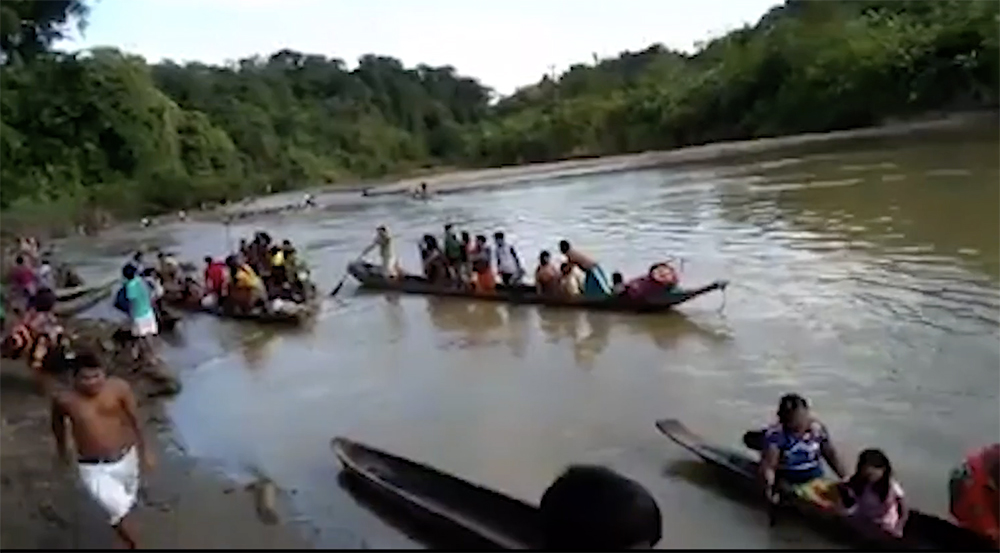Recorded by a community member of the Embera Dobida peoples in Colombia this harrowing footage on May 20, 2020 from the community of Catrú, municipality of Alto Baudó, Chocó captures this indigenous community fleeing the crossfire of an armed confrontation of ELN and AGC fighting for control of the area.
This is on top of the coronavirus pandemic that threatens these peoples. Although global, this pandemic does not level the playing field for all of us, it exacerbates and highlights the existing tensions and the fragility of society. Those already marginalised are bearing the very worst.
ELN and AGC are factional groups of fighters who have entered into the power vacuum caused since the ceasefire negotiations between FARC and the government of Colombia in 2016.
Embera leader in Panama, Candido Mezua, sheds more light on the situation.
The video shows critical and desperate moments from the population who are trying to escape the crossfire between two armed groups: the Autodefensas Gaitanistas (AGC) a neo-paramilitary and drug trafficking group, and a guerrilla group who came together after breaching the peace agreement. The Embera community is trying to survive in their forests and are now forced to relocate to a community far away from their home. It is very sad to see how they are forced to leave behind their crops, homes, daily activities, schools… forced to vanish from their current life environment making their forests now available for the armed groups. We are returning to a period of exiles now being run by the armed groups outside the law who are casting out the indigenous peoples without any preoccupation of their rights.
Did the community have any warning that the soldiers were coming?
The territory leaders were already under threat which was reported to the human rights commission and the indigenous table[needs clarification] after which the communities launched national protests calling out the government for breaching the peace treaty. The government ignored their petition and their duty to look after the lives of their people. The armed forces then grew stronger and started going after not only the indigenous peoples but also the ombudsmen, black communities and farmer groups, since the wooded/forest areas are an ideal placement to carry their illegal activities and they feel protected as they don’t follow the government’s law and order.
The communities and their leaders though were never warned about such armed groups conflict which is clearly reflected in the video as they community was clearly caught by surprise.
Although the Embera community was not part of the armed groups problem, they ended up suffering all the consequences.
Where are the people who fled now?
Membache, an Embera cacique [leader] told me the Embera people fled downstream and the families have settled in several far off locations. He is choosing not to disclose their exact locations from fear of the reprisal that could be taken against his people.
That being said, the pronouncement and demands will be carried via the regional organizations.
How are they surviving?
Right now with a lot of difficulties and with a very limited food supply. They have been getting support from other communities but it isn’t enough.
More than the food itself, what’s most challenging is the fact that a part of their lives was taken from them without a chance to fight. There is no expectation to receive help from the government as they’re acting with great delay and isn’t taken specific actions on this matter, only claiming to commit to agreements that are never fulfilled.
How is the pandemic affecting the threats faced by the Embera peoples?
The pandemic is another misfortune that kills people. Among the ones most affected lie those who are poor, more vulnerable, those who live in the jungle, who don’t have health insurance or money to afford medical attention. Although the pandemic doesn’t care about status, religion, or race, it is true that the ones who are taking the biggest hit are the most vulnerable amidst most indigenous people belong to. History repeats itself, the epidemic is brought from the outsiders. In some cases, the Embera community is returning to traditional medicine as a way to prevent and cure.
I am not familiar with the details of the indigenous communities in Colombia but do have certainty that the Embera community in Panama is taking action and, those who are coming back positive, are being treated with traditional medicine and are showing a fast recovery within 3 days which is showing the efficacy of the Embera traditional medicine.
However because such medicine doesn’t follow the standards of the OPS and the OMS, it cannot be shared with the people as such organizations are waiting for the “big vaccination” manufactured by the US. In the meantime, the focus is on boosting the countries economy but not the lives of its people.
